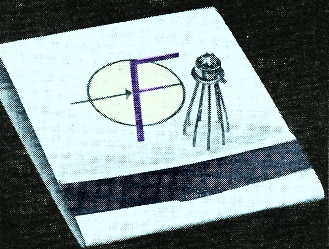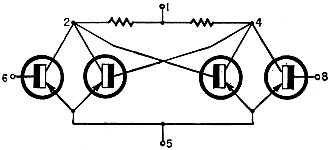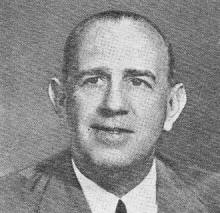|
June 1961 Radio-Electronics
 [Table of Contents] [Table of Contents]
Wax nostalgic about and learn from the history of early electronics.
See articles from Radio-Electronics,
published 1930-1988. All copyrights hereby acknowledged.
|
One of the interesting aspects
of reading through vintage magazines is finding current-at-the-time accounts of
industry happenings with people and companies still familiar to contemporary people
in the realm. In this June 1961 instance in Radio-Electronics magazine,
Dr. Robert Noyce of
Fairchild Semiconductors is mentioned. Most people today associate him with the founding of Intel. The
Microcircuit Flipflop was one of Fairchild's early integrated circuits, housed in
metal TO-5 and
TO-18 cans. The FCC had just approved
a method of "stereo multiplex" on the FM radio band that facilitated coexistence
of monaural (mono) and binaural (stereo) broadcasts. Hard to believe that was more
than sixty years ago (I was three years old). Also, sadly, news of Mr. Paul
Crosley's
- of radio, car, and home appliance fame - passing was announced. Atmospheric effects
on VLF, and use of ultrasonics for welding plastic also made the editors' cut.
New Briefs:
11/1957
| 8/1958 |
11/1959 |
2/1960 |
4/1960 |
8/1960 |
3/1961 |
5/1961 |
6/1961 |
12/1961 |
3/1963 |
4/1963 |
8/1963 |
9/1963 |
8/1964 |
12/1964 |
1/1967 |
3/1967 |
4/1967 |
9/1967 |
4/1968
News Briefs
 "Micrologic" Elements Cut Digital Circuit Size "Micrologic" Elements Cut Digital Circuit Size
A new departure in integrated microminiature circuit design may soon lead to
a"90% reduction in size and a 70% reduction in the cost of the logic section of
a computer," according to Dr. Robert Noyce of Fairchild Semiconductors, who demonstrated
the first of a new series of devices in New York City recently.

A Micrologic Flipflop photographed on a standard match boo. This
is the larger of the two Micrologic packages.

Schematic of the Micrologic Flipflop.
Called a Micrologic Flipflop, the element looks exactly like an ordinary transistor
except that it has then deposited on top of the slab, eight leads. As the sketch
indicates, it actually contains four direct-coupled transistors, with two load resistors.
Terminals 1 and 5 are battery supply and ground; 2 and 4 are outputs, and 6 and
8 are inputs. The flipflop is made by diffusing the transistors and resistors for
many units into a single slab of silicon. The metallic intraconnections are which
is then cut into the individual Micrologic elements. Each of these is mounted in
a standard TO-5 or TO-18 transistor case.
The Micrologic Flipflop is the first of a family of six. Five other devices -
Micrologic gate, half-shift register, buffer, half adder and counter adapter - will
be made available during the year. The six elements can be used to build the complete
logic or arithmetic section of a computer. The new Flipflop is priced at $120, a
price which is comparable to the equivalent conventional circuit. "This price will
be markedly reduced as production volume and sales increase," Dr. Noyce believes.
FM Stereo Multiplex Authorized June 1
Many FM stations begin stereo broadcasting on or shortly after June 1, under
an FCC ruling opening the FM broadcast band to stereo on that date. The system used
is a modification of that proposed to the commission by General Electric and Zenith.
Standards had not been issued at date of writing, but modifications were expected
to be minor.
Several companies state that prototype receivers and equipment for converting
stations are ready, and that receivers and adapters will be available to the public
on or shortly after June 1.
The Zenith-GE system was selected from a group including the Halstead, Crosby,
Calbest and Percival systems as one that "will produce stereophonic transmission
of good technical quality with only negligible effects on the monophonic main-channel
listener", according to the FCC. It uses an AM subcarrier on the main FM carrier,
and therefore has the further advantages that adapters or multiplex receivers will
be simpler and cheaper, and that a second subchannel can be used for commercial
"storecasting", restaurant music and similar services.
Radio-Electronics will describe the accepted system fully in the next issue,
and will follow with information on stereo adapters, tuners and receivers.
Long Waves Do Get Through
Radio propagation theory has been upset by a runaway satellite that is picking
up low-frequency signals that should have been absorbed by the ionosphere according
to all present beliefs.
Lofti, a small piggyback satellite, failed to separate from its carrier (Transit
III-B) and the two went into an unplanned orbit ranging from 100 to 600 miles from
the earth. The unplanned orbit caused the satellite to pass in and out of the ionosphere,
which permitted scientists of the Naval Research Laboratory to learn some unexpected
things. First was the fact that a substantial portion of the very-low-frequency
signals (3 to 30 kc) pass through the ionosphere into space. Second and more puzzling
was that the velocity of these signals is noticeably reduced when traveling through
the ionosphere.
Several practical applications of the new discoveries appear possible. One is
the possibility of a global system for communications with submerged submarines,
which can communicate only on VLF when under water. Another possibility is a network
of VLF stations as navigation radio beacons for manned or unmanned space vehicles.

Powel Crosley, Jr., one of the earliest large manufacturers of
radio sets, died in Cincinnati on March 28. He was 74 years old.
Powel Crosley Dead at 74
Powel Crosley, Jr., one of the earliest large manufacturers of radio sets, died
in Cincinnati March 28. He was 74 years old.
Crosley first became interested in radio when his son asked him for one in the
early days of broadcasting. When he discovered that the cheapest one on the market
cost $119, he produced his own, and in 1922 was mass-producing the one-tube Harko
radio for $20. Shortly after that he came out with the famous Trirdyn, a three-tube
reflex set with a stage of rf, regenerative detector and two stages of audio amplification.
It used the book type tuning condenser invented by Hugo Gernsback. For some time
Crosley was the world's largest radio manufacturer. Another "largest" was superpower
station WLW, which operated at 500 kilowatts till complaints of blanketing over
wide areas forced the FCC to cut his power to the present 50 kw.
Powel Crosley expanded his operations into the appliance field, and introduced
the shelf-in-door feature now found in all refrigerators, selling it as the Shelvador.
He also experimented with small, low-priced cars for a number of years, but admitted
later that he was "10 years too early" with the compact car. At the time of his
death, he was the principal owner of the Cincinnati Reds baseball team, in which
he had a controlling interest since 1936.
Ultrasonics at UHF
A new, efficient device for converting electrical energy into ultrasonic energy
and vice versa at microwave frequencies was described by D. L. White of Bell Telephone
Laboratories at the recent Institute of Radio Engineers international convention.
The new device is a piezoelectric transducer using a semiconductor depletion layer.
It will probably find its greatest use in ultrasonic delay lines, where its operation
at high frequencies and wide bandwidths will make it possible to store large amounts
of information.
The new transducer consists of a plate of piezoelectric semiconductor (such as
gallium arsenide) on which a thin metal film is deposited (see illustration). The
film constitutes a nonohmic rectifying contact which causes a depletion layer to
form. The thickness of the depletion layer can be controlled with a negative bias
voltage across the interface. When an ac voltage is applied, most of the voltage
drop occurs across the layer, which then behaves like a very thin piezoelectric
crystal bonded to a solid. Since the layer is thin, 10-3 to 10-5
cm, the electric field is very large and considerable piezoelectric stress can be
produced in the layer.
The depletion-layer transducer has several advantages over an ordinary transducer:
Because the layer is so thin, the greatest efficiency of the transducer is at
very high frequencies. Current models operate at under 1,000 mc but the frequency
range is expected to be extended to above 10,000 mc. In this high-frequency range,
this transducer should be as much as 100 times more efficient than any other known
transducer.
The thickness of the layer, hence the resonant frequency of the transducer, can
be varied by varying the dc bias voltage. This adds great flexibility to its use.
Present models measured at 600 mc have a bandwidth of 5% (30 mc) , an order of
magnitude larger than that of typical ceramic transducers operating at frequencies
be-low 10 mc. This means that a comparable increase should be expected in the amount
of information which can be transmitted.
Posted August 4, 2023
|








 "Micrologic" Elements Cut Digital Circuit Size
"Micrologic" Elements Cut Digital Circuit Size



